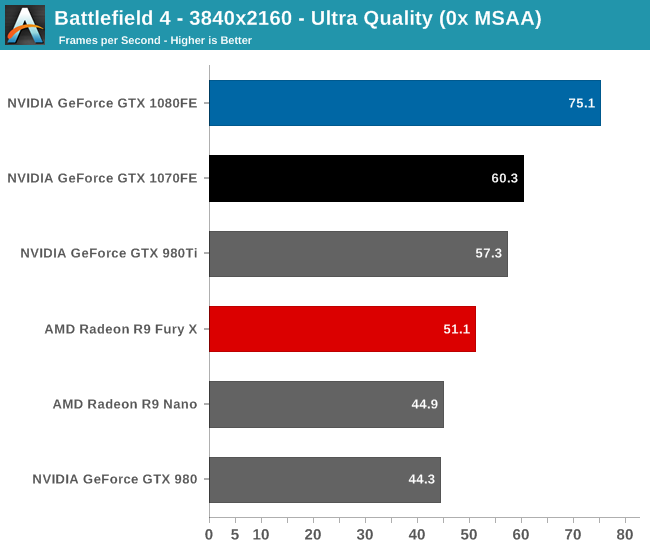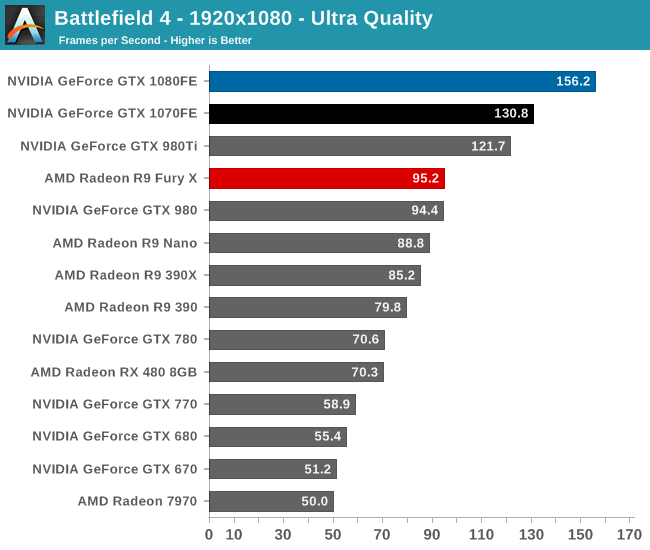The NVIDIA GeForce GTX 1080 & GTX 1070 Founders Editions Review: Kicking Off the FinFET Generation
by Ryan Smith on July 20, 2016 8:45 AM ESTBattlefield 4
One of the older games in our benchmark suite, DICE’s Battlefield 4 remains a staple of MP gaming. Even at its age, Battlefield 4 remained a challenging game in its own right, as very few mass market MP shooters push the envelope on graphics quality right now. As these benchmarks are from single player mode, based on our experiences our rule of thumb here is that multiplayer framerates will dip to half our single player framerates, which means a card needs to be able to average at least 60fps if it’s to be able to hold up in multiplayer.



As a game that has traditionally favored NVIDIA, Battlefield 4 makes for a very clean sweep of the field. The GTX 1080 takes top honors with the GTX 1070 some distance behind it. Notably, the two Pascal cards become the first cards to cross 60fps at 4K, which means that they’re the first cards we can be reasonably sure won’t have framerate dips below 30fps in multiplayer.
Looking at our standard generational comparisons, both GTX 1080 and GTX 1070 improve upon their predecessors by about what we’d expect; 67% and 58% respectively. Or to see how GTX 1080 and GTX 1070 compare, we find that the GTX 1080 leads its cut-down sibling by between 20% and 25%, with the gap increasing with the resolution. This is consistent with what we know about GTX 1080, as its bandwidth advantage means that it’s going to have an easier time pushing pixels at 4K, as the case is here.
Finally, to check in on the GTX 680, we find the GTX 1080 has only improved in performance by 2.8x, which is actually a bit less of a gain than the average. None the less we’ve gone from a card that can’t quite muster 1080p with 4xMSAA to a card that can easily handle 4K without any MSAA.










200 Comments
View All Comments
patrickjp93 - Wednesday, July 20, 2016 - link
That doesn't actually support your point...Scali - Wednesday, July 20, 2016 - link
Did I read a different article?Because the article that I read said that the 'holes' would be pretty similar on Maxwell v2 and Pascal, given that they have very similar architectures. However, Pascal is more efficient at filling the holes with its dynamic repartitioning.
mr.techguru - Wednesday, July 20, 2016 - link
Just Ordered the MSI GeForce GTX 1070 Gaming X , way better than 1060 / 480. NVidia Nail it :)tipoo - Wednesday, July 20, 2016 - link
" NVIDIA tells us that it can be done in under 100us (0.1ms), or about 170,000 clock cycles."Is my understanding right that Polaris, and I think even earlier with late GCN parts, could seamlessly interleave per-clock? So 170,000 times faster than Pascal in clock cycles (less in total time, but still above 100,000 times faster)?
Scali - Wednesday, July 20, 2016 - link
That seems highly unlikely. Switching to another task is going to take some time, because you also need to switch all the registers, buffers, caches need to be re-filled etc.The only way to avoid most of that is to duplicate the whole register file, like HyperThreading does. That's doable on an x86 CPU, but a GPU has way more registers.
Besides, as we can see, nVidia's approach is fast enough in practice. Why throw tons of silicon on making context switching faster than it needs to be? You want to avoid context switches as much as possible anyway.
Sadly AMD doesn't seem to go into any detail, but I'm pretty sure it's going to be in the same ballpark.
My guess is that what AMD calls an 'ACE' is actually very similar to the SMs and their command queues on the Pascal side.
Ryan Smith - Wednesday, July 20, 2016 - link
Task switching is separate from interleaving. Interleaving takes place on all GPUs as a basic form of latency hiding (GPUs are very high latency).The big difference is that interleaving uses different threads from the same task; task switching by its very nature loads up another task entirely.
Scali - Thursday, July 21, 2016 - link
After re-reading AMD's asynchronous shader PDF, it seems that AMD also speaks of 'interleaving' when they switch a graphics CU to a compute task after the graphics task has completed. So 'interleaving' at task level, rather than at instruction level.Which would be pretty much the same as NVidia's Dynamic Load Balancing in Pascal.
eddman - Thursday, July 21, 2016 - link
The more I read about async computing in Polaris and Pascal, the more I realize that the implementations are not much different.As Ryan pointed out, it seems that the reason that Polaris, and GCN as a whole, benefit more from async is the architecture of the GPU itself, being wider and having more ALUs.
Nonetheless, I'm sure we're still going to see comments like "Polaris does async in hardware. Pascal is hopeless with its software async hack".
Matt Doyle - Wednesday, July 20, 2016 - link
Typo in the lead sentence of HPC vs. Consumer: Divergence paragraph: "Pascal in an architecture that...""is" instead of "in"
Matt Doyle - Wednesday, July 20, 2016 - link
Feeding Pascal page, "GDDR5X uses a 16n prefetch, which is twice the size of GDDR5’s 8n prefect."Prefect = prefetch